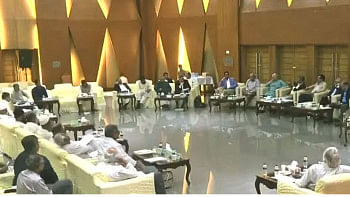Evidence leading to Mojaheed’s punishment

The International Crimes Tribunal cited several evidences in the death verdict it handed down to Ali Ahsan Mojaheed, the notorious al-Badr chief of 1971.
"We have also carefully considered accused's position of authority through which he asserted his effective influence and control over the Al-Badar men and the Al-Badar headquarter in Dhaka city and also the mode of participation of the accused to the commission of crimes proved and the the gravity of offences," the tribunal said.
"The fierceness of the event of the 'intellectuals killing' and the attack which was launched directing the unarmed civilians belonging to Hindu community causing numerous death, rape, persecution were grotesque and diabolical in nature and extremely detrimental to basic humanness."
"The accused by his acts, conducts, inciting statement, and speech substantially encouraged and abetted the Al-Badar men the principal perpetrators of intellectuals killing [charge no.6] to further an organized plan and common purpose, by virtue of his substantial position of authority on Al-Badar force," the verdict added.
It cited a report of The Daily Bhorer Kagoj, published on October 31, 2007, that quoted a April 24, 1971, article of The Daily Sangram where Mojahhed said his al-Badr force was the "angel of death".
"Al-Badar is a name! A wonder! A-Badar is a commitment! Where there is the so called freedom fighter, there is the Al-Badar. Where there is the miscreant, there is the Al-Badar. Al-Badar is the Azrail [Angel of death] in presence to the 'Indian agents' or the 'miscreants'," the report said.
He was chairing a meeting of the then Jamaat and Islami Chhatra Sangha in Mymensingh.
In July 2013, the International Crimes Tribunal-2 sentenced the 67-year-old Jamaat-e-Islami secretary general to death, jailed him for life and sentenced him to five years in prison in five separate charges.
"The workers belonging to purely Islami Chatra Sangha were called Al-Badar, the general patriotic public belonging to Jamaat-e-Islami, Muslim League, Nizam-e-Islami etc were called Al-Shams and the Urdu-speaking generally known as Bihari were called al-Mujahid," Mohi Uddin Chowdhury, a leader of peace committee, wrote in a book Sunset at Midday.
Accused Mujahid's statement on "Daily Sangram" on October 15th ,1971 speaks that
"The youths of the Razakars and al-Badar forces and all other voluntary organizations have been working for the nation to protect it from the collaborators and agents of India. But, recently it was observed that a section of political leaders like ZA Bhutto, Kawsar Niazi, Mufti Mahmud and Asgar Khan have been making objectionable remarks about the patriots," Mujahid's statement was recorded on The Daily Sangram's issue of October 15, 1971.
"Dressed in the black sweaters and khaki pants, members of the group, known as Al-Badar, rounded up their victims on the last three nights of the war………………………. Their goal, captured members have since said, was to wipe out all Bengali intellectuals who advocated independence from Pakistan and the creation of a secular, non-Moslem state………………If the war had not ended when it did, many Bengalis believe, Al-Badar would have succeeded. The bodies of 150 persons, many with their fingers chopped off or finger nails pulled out, were found in the brickyard. Hundreds more are believed buried in 20 mass graves nearby fields," said a report by Fox Butterfield.
The atrocities committed during 1971 were recorded by a New York Times article, written by CL Sulzberger as: "Hiroshima and Nagasaki are vividly remembered by the mind's eye primarily because of the novel means that brought holocaust to those cities. Statistically comparable disasters in Hamburg and Dresden are more easily forgotten; they were produced by what we already then conceived of as "conventional" methods. Against this background one must view the appalling catastrophe of East Pakistan whose scale is so immense that it exceeds the dolorimeter capacity by which human sympathy is measured. No one can hope to count the dead, wounded, missing, homeless or stricken whose number grows each day."

 For all latest news, follow The Daily Star's Google News channel.
For all latest news, follow The Daily Star's Google News channel. 



Comments